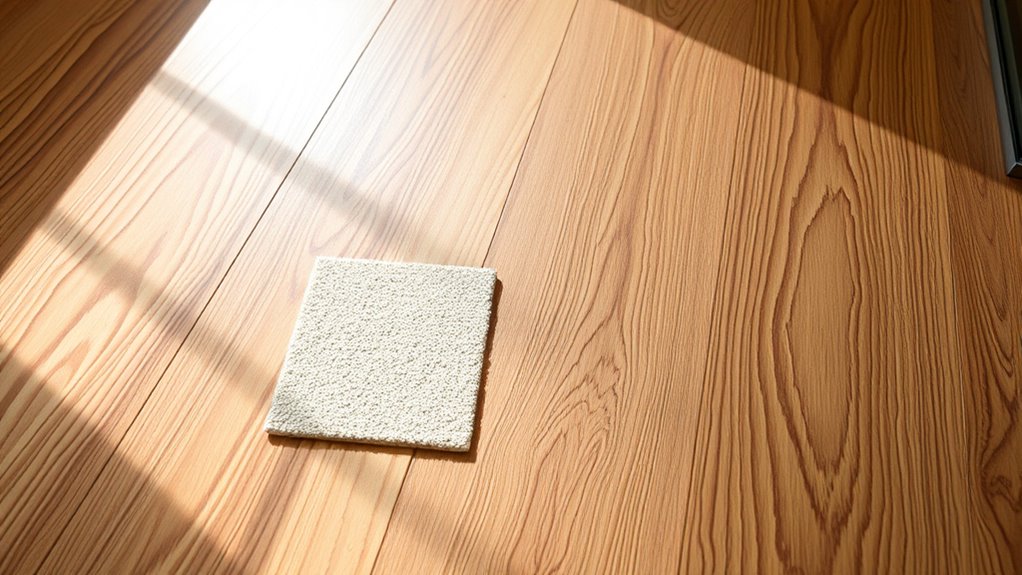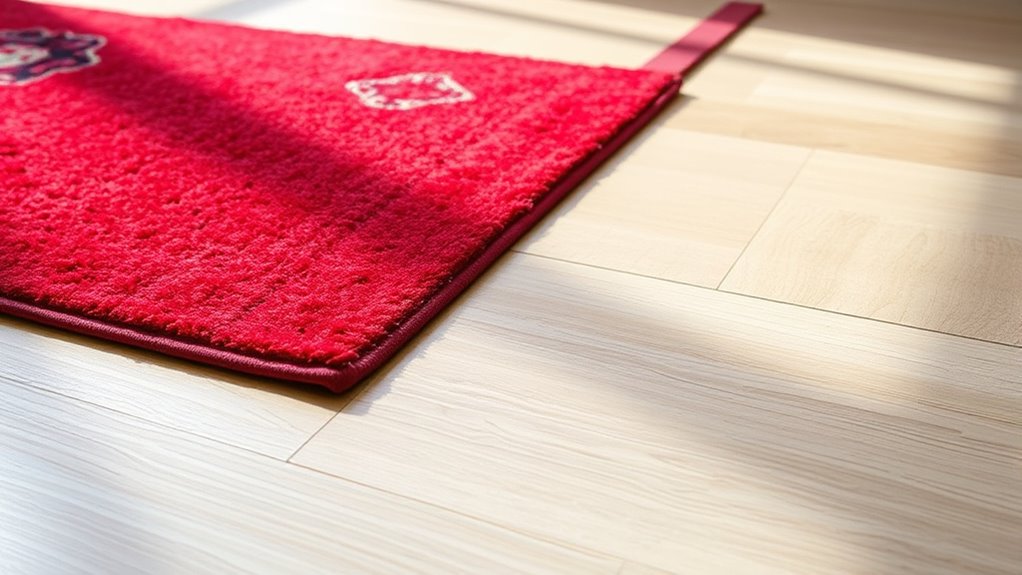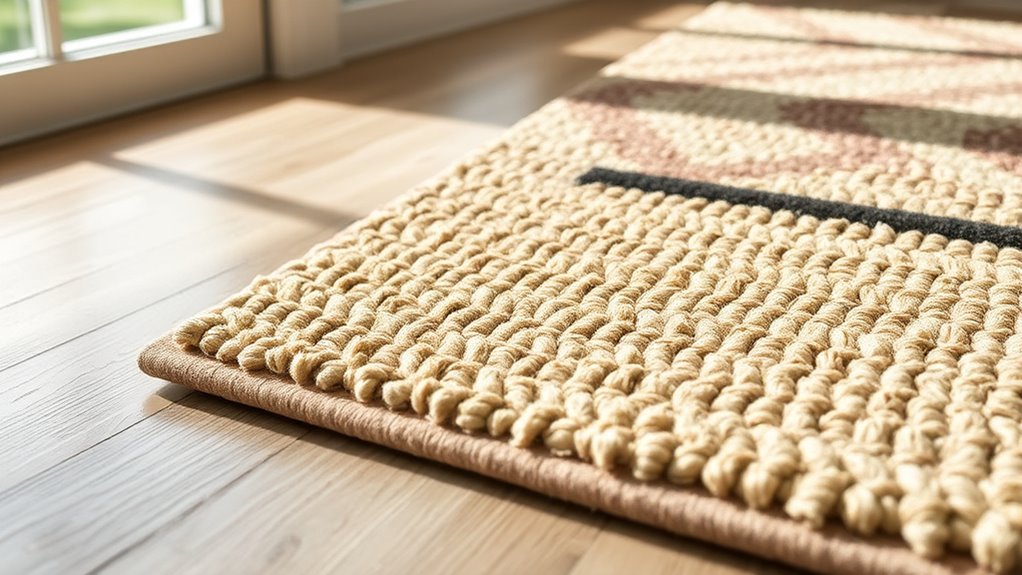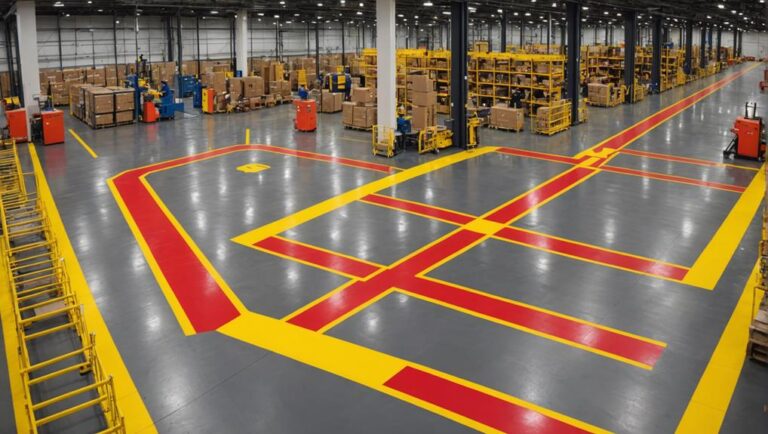When choosing rug backing for vinyl plank flooring, go for non-staining, pH-neutral, breathable materials like natural fibers or felt pads to prevent moisture buildup and chemical damage. Avoid latex or rubber backings, as they can cause discoloration, adhesive breakdown, and warping. Always test compatibility by placing a small rug section on your floor for 48 hours to check for adverse effects. Following proper selection and care will protect your flooring’s integrity and appearance—explore further for expert guidance and maintenance tips.
Understanding Vinyl Plank Flooring and Its Sensitivities

Although vinyl plank flooring is renowned for its durability and water resistance, you need to understand its specific sensitivities to guarantee peak performance and longevity. Vinyl is vulnerable to discoloration and damage from certain chemicals and adhesives commonly found in rug backings. For effective vinyl flooring maintenance, avoid placing rugs with non-breathable or rubberized backings directly on the surface, as they can trap moisture and cause yellowing or warping. When considering rug placement tips, choose breathable, natural fiber rugs or those with a vinyl-safe backing to prevent chemical reactions. Additionally, verify rugs are regularly lifted and cleaned to avoid dirt accumulation and abrasion. By understanding these technical nuances, you maintain your vinyl’s integrity while enjoying the freedom to personalize your space with rugs safely.
Common Types of Rug Backings and Their Effects on Vinyl
When selecting a rug for vinyl plank flooring, you need to evaluate the backing material carefully. Common backings like latex, rubber, and synthetic fibers each interact differently with vinyl, affecting its durability and finish. Understanding these interactions helps you prevent discoloration, indentations, and premature wear on your flooring.
Rug Backing Materials
Rug backing materials play an essential role in how a rug interacts with vinyl plank flooring, affecting both durability and piso protection. When selecting a rug backing, understanding rug backing types and rug backing comparison is vital for safeguarding your floor. Common backing materials include:
- Latex: Offers strong grip but can sometimes cause discoloration or stickiness on vinyl.
- Jute: Natural and breathable, yet abrasive and may trap moisture, risking floor damage.
- Synthetic mesh (e.g., polypropylene): Provides breathability and moderate grip without harmful residues.
Each material impacts your vinyl differently, so weigh their properties carefully. Choosing the right rug backing material guarantees freedom from unwanted damage while maintaining the aesthetics and longevity of your vinyl plank flooring.
Impact on Vinyl Durability
Since the backing material directly contacts your vinyl plank flooring, its characteristics greatly influence the floor’s durability. Rug backings made of natural rubber provide excellent grip without damaging the vinyl surface, aligning with essential vinyl maintenance tips. Conversely, latex or synthetic rubber backings can sometimes cause discoloration or adhesive breakdown, undermining your flooring care practices. Felt backings, while soft, may trap moisture, leading to potential vinyl warping or mold growth if not properly ventilated. Choosing a rug with a non-staining, breathable backing is vital to protect your vinyl’s integrity and extend its lifespan. By understanding these material effects, you maintain the freedom to enjoy your space without compromising your flooring’s performance or aesthetic, ensuring ideal durability through informed flooring care practices.
Why Some Rug Backings Cause Discoloration or Damage

Although vinyl plank flooring offers durability and moisture resistance, certain rug backings can interact negatively with its surface, leading to discoloration or even damage. You need to understand common rug discoloration causes, often stemming from material compatibility issues. Some rug backings contain chemicals or adhesives that react with vinyl’s plasticizers, causing stains or surface degradation. Additionally, trapped moisture beneath non-breathable backings accelerates discoloration through mold or mildew growth. To avoid these problems, consider these factors:
- Chemical composition of the backing and potential solvent reactions.
- Breathability to prevent moisture accumulation under the rug.
- Long-term adhesion effects causing plasticizer migration or surface softening.
Features to Look for in Vinyl-Friendly Rug Backings
When selecting a backing for use on vinyl plank flooring, you’ll want to prioritize materials that won’t compromise the floor’s integrity over time. Focus on rug backing types that offer excellent vinyl compatibility—these typically feature non-staining, pH-neutral, and non-adhesive properties. Avoid backings containing latex or rubber, as they can cause discoloration and degrade vinyl surfaces. Look for backings with a breathable design to prevent moisture buildup, which can lead to mold or warping beneath your flooring. Additionally, an anti-slip quality is essential to maintain safety without relying on adhesives that might damage your floor. By choosing rug backings engineered specifically for vinyl, you guarantee long-lasting protection, maintain aesthetic appeal, and preserve your flooring’s durability—all while enjoying the freedom to style your space confidently.
Benefits of Natural Fiber Rug Pads for Vinyl Floors

If you want to protect your vinyl plank flooring while enhancing rug stability, natural fiber rug pads offer a superior solution. These pads leverage natural fiber benefits such as breathability, durability, and chemical neutrality, which prevent discoloration and degradation of your vinyl floor. Choosing natural fiber pads aligns with your preference for eco friendly options, reducing synthetic waste and promoting sustainability.
Here’s why natural fiber rug pads excel for vinyl floors:
- Moisture Regulation – Natural fibers absorb and release moisture, preventing mold and mildew under rugs.
- Floor Protection – They cushion impact, reducing wear on vinyl planks without harsh chemicals.
- Enhanced Rug Stability – Their fibrous texture grips rug backing gently but firmly, minimizing movement.
Using natural fiber rug pads grants freedom from concerns about damage while supporting environmental responsibility.
The Role of Non-Slip Rug Pads in Floor Protection
Since vinyl plank flooring can be prone to scratches and scuffs from rug movement, non-slip rug pads play a critical role in floor protection by firmly anchoring rugs in place. These pads provide essential non slip benefits by creating friction between the rug and floor, reducing shifting that leads to wear. By stabilizing rugs, they prevent abrasive contact and preserve the floor’s surface integrity. Additionally, non-slip pads contribute to safety by preventing slips caused by rug sliding, ensuring secure footing in high-traffic areas. When selecting a pad, opt for materials designed to avoid chemical reactions with vinyl, ensuring the floor’s finish remains intact. Utilizing a high-quality non-slip rug pad balances floor preservation with your freedom to arrange rugs confidently and safely.
Avoiding Adhesive and Rubber-Based Backings on Vinyl
You should avoid rug backings with adhesives, as they can chemically bond to vinyl plank flooring and cause discoloration or surface damage. Rubber-based backings, while providing grip, often trap moisture and emit chemicals that degrade the vinyl over time. Instead, opt for materials like felt or natural fibers that guarantee floor protection without compromising vinyl integrity.
Risks of Adhesive Backings
Although adhesive and rubber-based backings might seem convenient, they pose significant risks when used on vinyl plank flooring. Adhesive residues can bond aggressively to vinyl surfaces, complicating backing removal and potentially damaging the floor. Here are three primary risks you should consider:
- Surface Damage: Strong adhesives can strip the vinyl’s protective layer during removal, causing irreversible harm.
- Residue Buildup: Leftover adhesive residues attract dirt, impairing the floor’s appearance and making cleaning difficult.
- Chemical Interaction: Certain adhesives contain solvents that react chemically with vinyl, leading to discoloration or weakening.
To maintain the freedom to change or clean your flooring without restriction, avoid rugs with adhesive backings. Opt for breathable, non-adhesive materials that preserve your vinyl plank flooring’s integrity and longevity.
Rubber Backing Impact
Beyond the risks posed by adhesive backings, rubber-based rug backings present their own set of challenges for vinyl plank flooring. Various rubber types, such as natural latex or synthetic nitrile, can interact chemically with vinyl, causing discoloration, staining, or degradation over time. When you compare backing types, rubber’s high moisture retention and limited breathability increase the likelihood of trapping humidity beneath the rug, which can warp or weaken the plank surface. Unlike felt or polypropylene backings, rubber lacks the necessary permeability to protect vinyl’s integrity. If you want to preserve your flooring’s freedom from damage, it’s critical to avoid rubber-based backings. Understanding these material interactions helps you make informed choices, ensuring your vinyl plank flooring remains pristine and durable without compromising on rug stability or comfort.
Safe Alternative Materials
When selecting rug backings compatible with vinyl plank flooring, it is essential to prioritize materials that minimize chemical reactions and moisture retention. To safeguard your floor’s integrity, avoid adhesive and rubber-based backings, which can cause discoloration or degrade the vinyl. Instead, focus on natural fiber options and alternative materials that offer breathability and chemical neutrality. Consider these top choices:
- Cotton or Jute Pads: These natural fibers allow airflow, reducing moisture buildup and preventing mold.
- Felt Backings: Made from compressed wool or synthetic fibers, felt provides cushioning without harmful adhesives.
- Woven Sisal or Coir: Durable and eco-friendly, these fibers resist trapping moisture and won’t react with vinyl.
How to Test Rug Backing Compatibility Before Placement
How can you guarantee a rug backing won’t damage your vinyl plank flooring before placing it? Conducting rug compatibility testing is essential. Begin by isolating a small rug section with its backing intact. Place it on an inconspicuous area of the vinyl flooring for 48 hours under typical room conditions. After removal, inspect both the rug backing and flooring for discoloration, adhesive residue, or surface deterioration. Flooring protection methods also include using pH-neutral barrier pads designed for vinyl planks to prevent chemical reactions. Avoid backing materials containing latex or rubber without prior testing, as they often cause staining. By rigorously evaluating rug backing compatibility in controlled conditions, you preserve your flooring’s integrity and maintain freedom in your décor choices without risking irreversible damage.
Maintenance Tips for Rugs on Vinyl Plank Flooring
Although vinyl plank flooring is durable, maintaining rugs placed on it requires careful attention to prevent damage or wear. To guarantee effective floor protection and prolong the life of both the rug and your flooring, follow these essential maintenance tips:
- Regularly perform rug cleaning using a vacuum with a soft brush attachment to remove dirt and debris that can scratch vinyl.
- Rotate rugs periodically to distribute wear evenly and prevent discoloration or indentations on the vinyl surface.
- Use a high-quality rug pad with non-slip, breathable backing specifically designed for vinyl floors to prevent slipping and moisture buildup.
Where to Buy Safe Rug Backings for Vinyl Floors
When sourcing safe rug backings for vinyl plank floors, you’ll want to explore specialty flooring stores that offer products specifically tested for compatibility. Online retailers provide a broad selection, allowing you to compare materials and user reviews efficiently. Additionally, eco-friendly material suppliers can provide backings free from harmful chemicals, ensuring both floor protection and indoor air quality.
Specialty Flooring Stores
Since vinyl plank flooring requires specific care to prevent damage, sourcing rug backings from specialty flooring stores guarantees you get materials designed for compatibility and safety. These stores focus on flooring accessories engineered to protect your investment, offering specialty rugs with safe, non-abrasive backings. When you visit, consider these key advantages:
- Expertise: Staff understand the chemical and physical interactions between vinyl and rug backings.
- Product Range: Access to advanced options like felt or natural rubber backings that avoid staining and slipping.
- Custom Solutions: Ability to tailor backing thickness and material to your flooring’s specifications.
Online Retailers Selection
While specialty stores offer expert guidance, online retailers provide unparalleled convenience and variety for purchasing safe rug backings compatible with vinyl plank flooring. When engaging in online rug shopping, you gain access to extensive selections, detailed product descriptions, and user-generated rug backing reviews that help you assess chemical safety and durability. Trusted platforms often categorize backings by material type, thickness, and slip resistance, enabling you to precisely match your vinyl floor’s requirements. Additionally, you can compare certifications ensuring non-toxicity and floor protection. To maintain your freedom of choice, leverage filter tools and customer feedback to verify compatibility with vinyl plank flooring, avoiding harmful adhesives or PVC-based backings. In sum, online retailers empower you with detailed data and broader options, ensuring you select a rug backing that preserves your flooring’s integrity.
Eco-Friendly Material Suppliers
Where can you find rug backings that combine eco-friendly materials with compatibility for vinyl plank flooring? To guarantee safe, sustainable sourcing and eco friendly options, consider these top suppliers:
- Natural Fiber Mills – Specialize in jute, cotton, and wool backings harvested through sustainable practices, guaranteeing biodegradability and chemical-free processing.
- Recycled Material Providers – Offer backings made from repurposed rubber or felt, reducing landfill waste while maintaining non-slip properties ideal for vinyl floors.
- Certified Green Manufacturers – Brands certified by environmental standards (e.g., OEKO-TEX, GOTS) assure rigorously tested, non-toxic backings safe for vinyl plank surfaces.
Choosing from these suppliers empowers you to protect your flooring and environment simultaneously, granting you freedom to design responsibly without compromising safety or durability.




